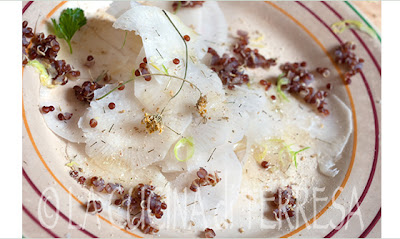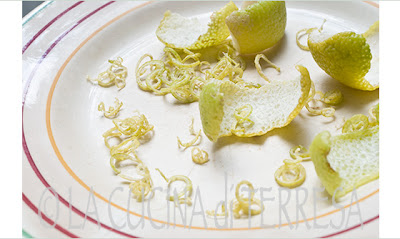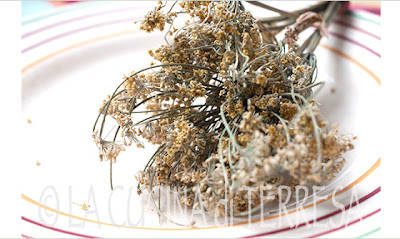Here it is, the last stretch of winter... and I'm back - after a long silence - with a simple winter salad recipe.
Early morning excursions to the marché (open-air market) are always invigorating - like a good cup of fresh steaming coffee - in these frosty months. And the rosy-cheeked vendors deserve more than a "hats off" for their steely resolve, pitted as they are against the pronounced dark morning hours and nipping frost.
And speaking of marchés...
It's quite interesting that in a city like Paris where they certainly abound... there is not one TRUE farmer's market. Each marché, too be sure, is an overflowing, multicolored vista of fresh fruits and vegetables... unfortunately a majority of the produce comes from large monoculture commercial enterprises and the choices available are rather identical (and seemingly comprised of less and less choice).
Local farmers and producers must be spied out (even at the 2 or 3 100% organic marchés), and if you know the signs to look for, you'll stumble on one or two or three during your morning stroll along the vendor stands.
— All of their produce in displayed in old, weathered wooden, and unlabled, crates.
— There will always be a sign hanging somewhere at the back of the stand with the name of the producer and the farm's whereabouts. There might also be a sign hanging out front with the words "Maraîcher" or "Producteur" (farmer or producer).
— You'll see vigorous hands with dirt well embedded beneath fingernails, and a certain vim and vigor, even a joyful pride on the face of the producer him/herself, who is always there, plying his/her trade.
I suppose the lack of a true farmer's market goes unnoticed simply because each market does give the semblance of its produce having just "come from the farm."
I've decided to begin to make a list of the various maraîchers at the different marchés... Eventually I hope to make the rounds of them all... and fill you in!
I'll start with the one I often go to at Nation, in the 12th arrondissement — the Cours de Vincennes marché — which takes place every Wednesday and Saturday from 8 am - 1:30 pm. I think it's one of the richest in "farmers bringing in their produce" in the whole city.
Here is a list of the producteurs that offer their wares there each week, and of course at their stalls you will find the truly seasonal and exceptionally savory fruits and vegetables from their terroir :
— Elyane et Gerard GOBEAUT :: Cours de Vincennes SATURDAY
— JF le PETIT : producteur de Normande :: Cours de Vincennes SATURDAY
— GAEC de VILLEDIEZ (Aury-Doublet) :: Cours de Vincennes WEDNESDAY & SATURDAY
— Daniel NAUDIN : Fontenay Trésigny :: Cours de Vincennes WEDNESDAY & SATURDAY
— P. LANTENOIS :: Cours de Vincennes MERCREDI & SATURDAY
— Bernard GROULT, Val d'Oise :: Cours de Vincennes SATURDAY
— Eric MARTINET Cours de Vincennes WEDNESDAY & SATURDAY
Next time you're in Paris, take a little journey to check them out and cart home of bit of their plenty.
As for that salad I mentioned up a few lines...
BLACK SPANISH RADISH-RED QUINOA SALAD – serves 4
= best in winter and early spring
150 gr black Spanish radish (I prefer the elongated variety)
75 gr red quinoa
Generous handful hazelnuts
Fresh dill
Dried wild fennel seeds, (if unavailable, regular fennel seed, slightly crushed will work)
1 organic lemon, for curlicues and juice
½ organic orange, for juice and zest
Extra-virgin olive oil
Unrefined sea salt and freshly ground pepper
— Make the lemon curlicues (photo below or watch my video): Wash the lemon with a vegetable scrubber then dry. Using a vegetable peeler, remove the zest. Cut off any pith by laying a very sharp paring knife flat against the pith and, pressing down, zigzagging back and forth to remove the pith from the zest. Slice lengthwise into very - very - thin strips. Dry in an oven preheated to 110 ˚C (225 ˚ F) for 5 – 10 minutes, or until the zests begins to curl, shaking from time to time. Watch them carefully, as you don’t want the edges to brown. Remove and set aside. You can also make the lemon strips the night before and just leave out in a bowl until the morning. Cover until ready to use later in the day. Can be kept in a glass jar for 2 days.
— Wash the orange with a vegetable scrubber then dry. Zest with a zester (Microplane zesters work great)
— Toast the hazelnuts in an oven preheated to 160 ˚C (325 ˚F) for 10 – 15 minutes, or until the skins begin to blister and the aroma of roasted nuts begins to seep from the oven. Shake the pan once or twice during roasting. (Bring them to room temperature before toasting if keeping them in the refrigerator.) Wrap in a dishtowel and vigorously rub between your hands to remove the skins. Let stand until cool then rub again. I then take them between my hands and rub them over the towel or sink, to remove any more willing skin. Don't worry about the skin that refuses to surrender. Coarsely chop.
— Wash the quinoa in a mesh strainer under running water over a large bowl. Repeat 2 – 3 times, until the water becomes clear. Bring 300 ml of water to a boil in a small saucepan, add a pinch of salt and stir in the quinoa. Cover and cook over medium-low heat until the water is absorbed (30 - 35 minutes). Remove from the heat and let stand for five minutes. Transfer to a large bowl, fluff up with a fork, and let cool.
— Peel the radish and, using a mandolin, slice crosswise into paper-thin slices. Transfer to a bowl and drizzle with a couple tablespoons of good olive oil. Toss to coat. Give a couple three squeezes of both lemon and orange juice, a nice pinch of sea salt, and toss again. Taste for seasoning and add more oil, salt, lemon and/or orange juice as needed.
— Arrange the radish slices in an airy mound in the center of 4 large salad plates. Sprinkle 4- 5 tablespoons of cooked quinoa just outside the radish slices, around the edge of the plate. Drizzle a bit of olive oi, along with a squeeze of orange juice, over the quinoa. Garnish with the hazelnuts, a few leaves of fresh dill or fresh wild fennel (in spring), and a pinch of the fennel seeds. Finally give each plate a couple generous twists of the pepper grinder. (You might have a bit of quinoa left over… to use for another dish.)
Note: You can gather your own wild fennel seeds out in any warm countryside in late summer and dry them, hanging them upside down in a dark, dry airy place.
Lemon curlicues
Dried wild fennel seeds



